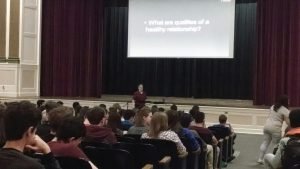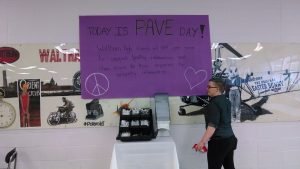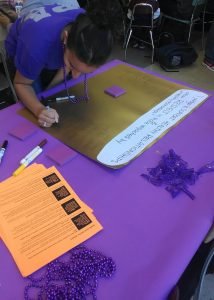From time to time we like to pull back the curtain and show you a behind-the-scenes look at REACH staffers doing their work. This week, our Youth Education Specialist, Dani Patrick, takes you along on a day spent with teenagers talking about healthy relationships. For previous “day in the life” pieces, read about our former Community Organizer, one of our Community Advocates, or the first 48 hours in Shelter.

I begin most days in a classroom. Today my first class starts at 7:30 a.m. When I get there, I check in with the teacher and we chat about some of her experiences talking to teens about healthy relationships. She mentions the first class of the day is a large one, and offers to move students if they get too rowdy. I like to create an open dialogue with teachers so we can support each other with anything that comes up during their classes. This teacher and I will be working a lot together in the next few weeks; I’m leading 4 sessions with each of the 12 freshman health classes at the school. One of the challenges that comes up in my work is that every school’s schedule is different. Today I will be seeing some classes for our first session together and some for the second session.

The first class of the day is session #1 of REACH’s curriculum, so I start out by introducing myself and explaining that we are doing a program on healthy relationships and dating abuse. One of my strategies to engage students is to make everything as interactive as possible. Today I ask them to raise their hands if they have friends who are dating or hooking up, if they have known someone in a healthy relationship, and finally if they have known someone in an unhealthy relationship. Almost all of their hands shoot up on the first two questions, and a third of the room tentatively raises their hands for the third. I start out by sharing an experience where a friend asked me for support around an abusive relationship. I explain that my friend felt comfortable reaching out to me in part because we had already talked about these issues, and that one of my goals for our classes together is to create a safe space for open conversations.
Our first activity of the day, passed on by Boston Area Rape Crisis Center, is about boundaries. I have every student find a partner to start with and I call out instructions to touch—“elbow to elbow,” “knee to knee,” and “finger to finger…like ET!” This is one of the activities I like to be silly with; given that dating violence can be a hard topic to talk about, I try to break up heavy conversations with humor when I can. I have them switch partners several times, so they get a chance to participate with people they don’t know as well. Finally I call out to touch “stomach to stomach” and “nose to nose.” The room fills with awkward laughter and students saying “what?” or “no way.” One of the takeaways of this activity is that we are already paying attention to other people’s boundaries and body language. Even if someone doesn’t verbally say no to something, we can tell if they are uncomfortable. Students share some of the ways they could tell their partner was uncomfortable: they had a weird facial expression, they hesitated, they didn’t make eye contact.
We shift to a larger conversation about boundaries and why they are important for healthy relationships. I ask five volunteers to read examples of boundaries young people might have. Among them are: “Please don’t call me after midnight,” “I don’t give anyone my password,” and “I’m not interested in kissing right now.” I look at the clock and realize we are about halfway through the class. I lead another interactive activity where students share their opinions about what would be healthy or unhealthy in a relationship, and then end with some practical tools they can use to communicate boundaries in a healthy way.
The bell rings and students leave the room. The next class is on session #2 so today we will be talking about dating violence. I start by sharing a statistic: 1/3 young people have experienced physical, emotional, or sexual abuse in a relationship. Sometimes teens feel like dating abuse isn’t an issue that impacts them– that it wouldn’t happen at their school or with their friends. I explain that even if they don’t know someone who has experienced abuse, they probably will know someone in the future, so it’s important to be able to recognize warning signs and know how to support a friend. I start off the conversation in an open ended way, asking them what comes to mind when they hear the phrase “dating abuse” or “domestic violence.” We end up talking about things going on in the media; today we talk about Kesha and her recent court case, as well as how the NFL has been responding to cases of domestic violence. We end with an interactive story that demonstrates common patterns and dynamics in abusive relationships.
The next two classes go much like the first. A student sticks around after the last class and asks to talk to me. She is trying to figure out if she should get back together with her ex. We talk some about her feelings and the potential positives and negatives of getting back together. Often a few students at each school will talk to me one-on-one, usually about issues they are dealing with in their own relationships or because they are concerned about a friend.
I head out and make my way to Waltham High School, where I coordinate the PAVE (Peers Against ViolencE) pe er leadership program along with one of the counselors at the school. The group is made up of 14 students. They go through a week-long dating violence and leadership development training over the summer and then meet weekly to organize campaigns around their school. For the last month we have been preparing for “PAVE Day,” our big event for Teen Dating Violence Awareness Month, where we encourage students, faculty, and staff at the high school to wear purple to support healthy relationships.
er leadership program along with one of the counselors at the school. The group is made up of 14 students. They go through a week-long dating violence and leadership development training over the summer and then meet weekly to organize campaigns around their school. For the last month we have been preparing for “PAVE Day,” our big event for Teen Dating Violence Awareness Month, where we encourage students, faculty, and staff at the high school to wear purple to support healthy relationships.
“PAVE Day,” has finally arrived. I walk to the cafeteria, where most of the PAVE Day activities  arehappening and join a colleague from REACH who has been supporting the peer leaders for the first half of the day. It’s the third and last lunch. The peer leaders, wearing purple PAVE t-shirts, walk around the cafeteria, engaging students in conversations about dating violence and handing out purple beads and candy. Some of them stay by our main table, encouraging students to sign a pledge and to write qualities of a healthy relationship on purple post-it notes to add to a huge banner. Before we know it, the lunch is over and I help clean up before heading back to the office to spend some precious time with colleagues, respond to emails, and prepare for the next day’s classes.
arehappening and join a colleague from REACH who has been supporting the peer leaders for the first half of the day. It’s the third and last lunch. The peer leaders, wearing purple PAVE t-shirts, walk around the cafeteria, engaging students in conversations about dating violence and handing out purple beads and candy. Some of them stay by our main table, encouraging students to sign a pledge and to write qualities of a healthy relationship on purple post-it notes to add to a huge banner. Before we know it, the lunch is over and I help clean up before heading back to the office to spend some precious time with colleagues, respond to emails, and prepare for the next day’s classes.
To find out more about Peers Against ViolencE and REACH’s prevention work with youth, visit our website, email me, or call me at (781) 891-0724 ext.119. You can also follow us on Facebook and Twitter.





